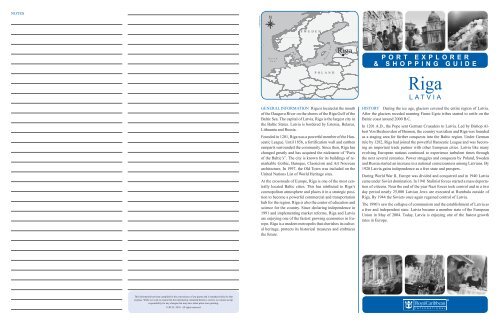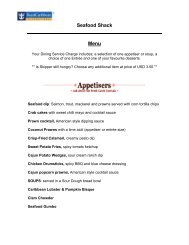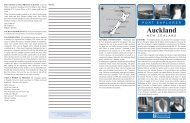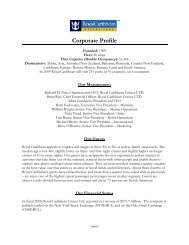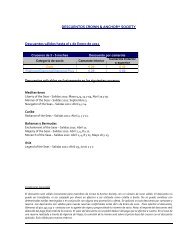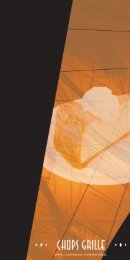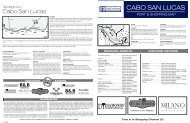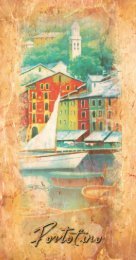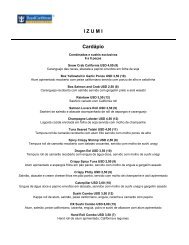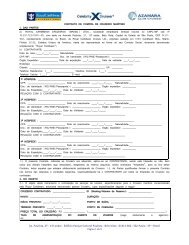port explorer & shopping guide - Royal Caribbean International
port explorer & shopping guide - Royal Caribbean International
port explorer & shopping guide - Royal Caribbean International
Create successful ePaper yourself
Turn your PDF publications into a flip-book with our unique Google optimized e-Paper software.
NOTES<br />
© 2010 maps.com<br />
S W E D E N<br />
N o r t h<br />
S e a<br />
B<br />
a l<br />
t i<br />
S e<br />
c<br />
a<br />
Riga<br />
PORT EXPLORER<br />
& SHOPPING GUIDE<br />
P O L A N D<br />
Riga<br />
LATVIA<br />
GENERAL INFORMATION Riga is located at the mouth<br />
of the Daugava River on the shores of the Riga Gulf of the<br />
Baltic Sea. The capital of Latvia, Riga is the largest city in<br />
the Baltic States. Latvia is bordered by Estonia, Belarus,<br />
Lithuania and Russia.<br />
Founded in 1201, Riga was a powerful member of the Hanseatic<br />
League. Until 1856, a fortification wall and earthen<br />
ramparts surrounded the community. Since then, Riga has<br />
changed greatly and has acquired the nickname of “Paris<br />
of the Baltic’s”. The city is known for its buildings of remarkable<br />
Gothic, Baroque, Classicism and Art Nouveau<br />
architecture. In 1997, the Old Town was included on the<br />
United Nations List of World Heritage sites.<br />
At the crossroads of Europe, Riga is one of the most centrally<br />
located Baltic cities. This has attributed to Riga’s<br />
cosmopolitan atmosphere and places it in a strategic position<br />
to become a powerful commercial and trans<strong>port</strong>ation<br />
hub for the region. Riga is also the center of education and<br />
science for the country. Since declaring independence in<br />
1991 and implementing market reforms, Riga and Latvia<br />
are enjoying one of the fastest growing economies in Europe.<br />
Riga is a modern metropolis that cherishes its cultural<br />
heritage, protects its historical treasures and embraces<br />
the future.<br />
HISTORY During the ice age, glaciers covered the entire region of Latvia.<br />
After the glaciers receded roaming Finno-Ugric tribes started to settle on the<br />
Baltic coast around 2000 B.C.<br />
In 1201 A.D., the Pope sent German Crusaders to Latvia. Led by Bishop Albert<br />
Von Buxhoevden of Bremen, the country was taken and Riga was founded<br />
as a staging area for further conquests into the Baltic region. Under German<br />
rule by 1282, Riga had joined the powerful Hanseatic League and was becoming<br />
an im<strong>port</strong>ant trade partner with other European cities. Latvia like many<br />
evolving European nations continued to experience turbulent times through<br />
the next several centuries. Power struggles and conquests by Poland, Sweden<br />
and Russia started an increase in a national consciousness among Latvians. By<br />
1920 Latvia gains independence as a free state and prospers.<br />
During World War II, Europe was divided and conquered and in 1940 Latvia<br />
came under Soviet domination. In 1941 Stalinist forces started a mass de<strong>port</strong>ation<br />
of citizens. Near the end of the year Nazi forces took control and in a two<br />
day period nearly 25,000 Latvian Jews are executed at Rumbula outside of<br />
Riga. By 1944 the Soviets once again regained control of Latvia.<br />
The 1990’s saw the collapse of communism and the establishment of Latvia as<br />
a free and independent state. Latvia became a member state of the European<br />
Union in May of 2004. Today, Latvia is enjoying one of the fastest growth<br />
rates in Europe.<br />
This information has been compiled for the convenience of our guests and is intended solely for that<br />
purpose. While we work to ensure that the information contained herein is correct, we cannot accept<br />
responsibility for any changes that may have taken place since printing.<br />
© RCCL 2010. All rights reserved.
5<br />
Places of Interest<br />
Old Town of Riga was a center of commerce during the middle Ages.<br />
The wealthy merchants in an effort to out do one another, left the city<br />
with many architectural treasures. Some of the most famous monuments<br />
include; St. Peter’s Church with its famed spire, St. George’s<br />
Church, St. John’s Church, a part of restored city wall and the medieval<br />
John’s yard. The Old Town has exceptionally beautiful examples<br />
of Art Nouveau architecture of late 19th and early 20th centuries.<br />
1<br />
Dome Square is the very heart of Old Riga. The massive 13th<br />
century red-brick Dome Cathedral is situated on the square. The<br />
interior walls are covered with memorabilia commemorating the accomplishments<br />
of former parishioners. The Cathedral is home to the<br />
famous 19th century Dome organ containing over 6 thousands pipes<br />
making it one of the largest in Europe.<br />
2<br />
“Three Brothers” are the oldest stone residential buildings in<br />
Riga. The Three Brothers represent different stages in the architectural<br />
development from medieval to Baroque. The oldest of the<br />
three buildings dates back to the 15th century. The other two were<br />
built in the 17th and 18th centuries. The Riga Museum of Architecture<br />
is located in Building #19.<br />
2<br />
1<br />
PLACES OF INTEREST<br />
3<br />
4<br />
3<br />
6<br />
“House of Cats” is situated near Dome Square and is famous for<br />
the cat sculptures perched on the roof as well as the story that is<br />
associated with them.<br />
4<br />
Powder Tower dates back to the 14th century. The structure is<br />
the only surviving defense tower of the old city walls. The Powder<br />
Tower is now the home of the Museum of War which has exhibits<br />
of weapons and artifacts spanning 700 years.<br />
5<br />
Riga Castle dates from the 14th century. Built for the German<br />
Knights, it was destroyed and then rebuilt again several times.<br />
The castle is now home to the president of Latvia.<br />
6<br />
The<br />
Freedom Monument was dedicated in 1935 and symbolizes<br />
the struggle of the Latvian people for independence. The monument<br />
was designed by Latvia’s most famous sculptor and became the<br />
hub of the Latvian independence movement in the late 1980s.<br />
© 2010 maps.com<br />
Beyond Riga<br />
Big Choral Synagogue was built in 1868 and was the biggest and<br />
most beautiful synagogue in Riga. It was famous for its singers, both<br />
cantors and the choir. On July 4th, 1941, the Synagogue was burned<br />
down with 300 people inside. On July 4th, 1988 a memorial stone was<br />
inaugurated on the site.<br />
Riga Motor Museum is the biggest antique vehicle museum in the<br />
Baltic countries. The museum has on display more than 100 unique<br />
vehicles. Curiosities are wax life-size figures of Stalin in his armored<br />
Tchaika and Brezhnev at the wheel of his crashed car.<br />
Rumbula is located on the outskirts of Riga. Approximately 25 thousand<br />
Jews from across Europe were massacred during World War II in<br />
the pine forest of Rumbula. In late 1960’s a tombstone was placed on<br />
the mass grave of victims of Nazi terror.<br />
Latvian Ethnography Open-Air Museum was founded in 1924 and<br />
lies in the outskirts of Riga on the coast of Lake Jugla. The museum<br />
presents an op<strong>port</strong>unity to learn about the history and life in Latvia<br />
in authentic surroundings. The museum is divided into four regions<br />
according to the territorial division of Latvia’s provinces – Vidzeme,<br />
Kurzeme, Zemgale and Latgale. The museum is home to peasants’<br />
farmsteads, windmills, wooden churches and pubs from the 16th<br />
through the 20th centuries.<br />
Sigulda Castle dates from the 13th century. The castle was constructed<br />
by Teutonic invaders and was destroyed in the 18th century. Some<br />
of the ruins have been partially restored.<br />
Turaida Castle is located about 50 km northeast of Riga and is one<br />
of the most visited medieval castles in Latvia. Dating from the 12th<br />
century it was once the residence of the Archbishops of Riga. Here one<br />
can find the grave of Turaida Rose located under an old linden tree.<br />
She was the heroine of a true love story from the 17th century.<br />
SHORE EXCURSIONS To make the most of your visit to Riga and<br />
surrounding areas we suggest you take one of our organized Shore Excursions.<br />
For information concerning tour content and pricing, consult<br />
your Shore Excursion Brochure or contact the Shore Excursion Desk.<br />
When going ashore, be advised to take with you only necessary items<br />
and secure any valuables onboard.<br />
LOCAL CUSTOMS Bargaining: Prices in large stores are fixed. Bargaining<br />
may take place in smaller owner-managed shops, and some<br />
local street vendors.<br />
Tipping: Generally a service charge will be included on the bill; otherwise<br />
10-15% is a good <strong>guide</strong>line.<br />
Local Cuisine: Latvian recipes typically contain fresh local ingredients<br />
commonly available such as pork, bacon, fish, potatoes, cabbage,<br />
onions and pickles. Often served are Piragi, a pastry made from<br />
wheat flour filled with a meat stuffing, Borshch, a soup made from<br />
beets and sauerkraut. Bread is very im<strong>port</strong>ant on a Latvian table. Dark<br />
rye breads are popular but there are many different wheat and barley<br />
breads to be found as well.<br />
Kimenu siers is a traditional Latvian cheese often served at celebrations.<br />
Pickled mushrooms are a Latvian specialty.<br />
Drink Specialties: Latvia has been producing many fine quality beers<br />
for centuries. Among the some of the popular local brands are Aldaris,<br />
Cesis and Lacplesis. One of the best selling spirits is Kristala dzidrais,<br />
a well liked Latvian-produced vodka. In the whiskey category,<br />
Zverkavis has an interesting taste. The national Liqueur is Riga’s Melnais<br />
Balzams. The thick, dark drink is made from a complicated recipe<br />
and is said to be an acquired taste. For a cold weather climate, Latvia<br />
has some very good local wines. Bottled water is recommended.<br />
SHOPPING FACILITIES There are many <strong>shopping</strong> op<strong>port</strong>unities<br />
in Riga especially in the Old City district. There are quaint specialty<br />
stores as well as <strong>shopping</strong> malls. The “Galerija Centrs” is one of Riga’s<br />
best known department stores and has undergone extensive renovations<br />
to create a modern <strong>shopping</strong> experience. The Central Market<br />
is a chaotic and fascinating place to explore. Located southwest of the<br />
Old City next to the main train station, the Central Market is one of the<br />
largest of its kind in Europe. Shopping hours are generally from 8:00<br />
am to 6:00 pm Monday thru Saturday. There may be some touristoriented<br />
shops that stay open later. Most small shops are closed on<br />
Sunday.<br />
Items of interest are; Latvian made Laima Candies, Riga Black Balsam,<br />
jewelry, Baltic amber, leather items, linen, antiques, music,<br />
handicrafts and souvenir items. There are of course varying degrees of<br />
quality but it is possible to obtain some real bargains as well as some<br />
unique souvenirs.<br />
LOCAL CURRENCY The official unit of currency is the Latvian Lat<br />
(LVL). The Lat is subdivided into 100 Santims. The new notes are in<br />
denominations of 5, 10, 20, 50, 100 and 500 Lats. Coins can be found<br />
in denominations of 1 and 2 Lats and 1, 2, 5, 10, 20, and 50 Santims.<br />
Most major shops and restaurants accept major credit cards.<br />
POST OFFICE AND TELEPHONE FACILITIES The main Riga<br />
Postal Centre “SAKTA” is located 32 Brivibas bulv..<br />
Public Telephones are easy to use. The phones are activated with a<br />
Lattelecom calling card. Phone cards can be purchased at post offices<br />
or from newspaper kiosks. To make an <strong>International</strong> call you must<br />
purchase an <strong>International</strong> phone card. You can also place calls with<br />
your personal calling card using the following access codes:<br />
AT&T: 800.2.288<br />
MCI: 800.8.888<br />
TOURIST INFORMATION There are two Tourism Information Offices<br />
in Riga. One is located in the Old City in the House of Blackheads<br />
complex at Ratslaukums 6 (I-2).<br />
The second is located at the bus terminal at Pragas 1.<br />
TRANSPORTATION Taxis are in limited supply in the pier area.<br />
Fares should be negotiated prior to entering the cab and departing.<br />
USEFUL WORDS AND PHRASES<br />
Yes • Ja<br />
No • Ne<br />
Hello • Labdien<br />
Farewell • Uz Redzesanos<br />
Thank You • Paldies<br />
You’re Welcome • Ludzu


